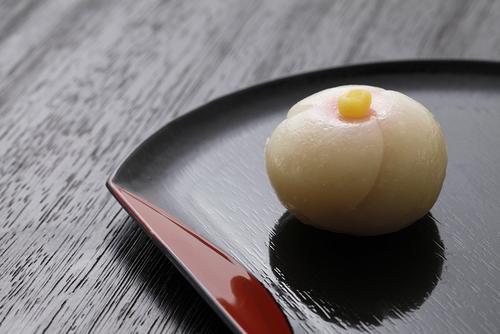Japanese sweets, a representative example of Japanese cuisine, are also very popular among people living overseas.
Japanese sweets are not only delicious but also pleasing to the eye. However, I think that many people who love Japanese sweets are unaware of their meaning, classification, and history.
So in this article, I would like to explain the appeal and basic knowledge of wagashi in an easy-to-understand way in order to clarify the specific definition of "what exactly are wagashi?"
What are Japanese sweets?

Wagashi is a general term for traditional Japanese sweets.
Japanese sweets, which are closely tied to the four seasons, have the appeal of expressing a sense of the season through their visual beauty in addition to their delicious taste. This characteristic is one of the reasons why Japanese sweets are popular with people all over the world.
The history of Japanese sweets
There are many points in the history of Japanese sweets that contribute to their unique characteristics.
First of all, it is said that wagashi originated from fruits and nuts that were snacks in the Yayoi period. At that time, people had little food, so they ate these to satisfy their hunger. That's why the name wagashi (Japanese sweets) includes the two kanji characters that represent snacks from the past.
- The "ka" in "Kashi" (sweets): Fruit
- The "ko" in confectionery: seeds
During the Heian period, sweets were presented to the Imperial Court. With the development of the tea ceremony among the upper classes during the Kamakura period, wagashi began to be served with tea. During the Edo period, the culture of wagashi spread to the common people as sugar imports increased, and in Kyoto, wagashi took on a form similar to the beautiful and delicate wagashi of today.
The difference between Japanese and Western sweets

Western sweets, which are often compared to Japanese sweets, were introduced to Japan at the same time as Western culture began to spread towards the end of the Taisho period. There are three major differences between Japanese sweets and Western sweets:
Ingredients and flavor
The main ingredients of Japanese sweets are plant-based, such as rice, wheat, and beans. Therefore, although they are generally low in calories, they tend to be very high in carbohydrates due to the large amount of sugar and starch they contain.
On the other hand, Western sweets use many animal-based ingredients such as eggs, butter, and milk. Western sweets, which use fresh cream instead of water, tend to be higher in fat and sweeter than Japanese sweets.
How to make it
Japanese sweets are mainly made by artisans using manual methods such as boiling, kneading, and steaming.In contrast, Western sweets, like Japanese sweets, have artisans such as pastry chefs, but many types are made by mixing ingredients all at once in a mixer or using appliances such as ovens.
Appearance
As mentioned above, wagashi, which are made with the four seasons of Japan in mind, tend to have motifs of seasonal flowers and animals. In general, they tend to be small and round, so they can be shaped by the artisan's hands. On the other hand, Western-style sweets often have gorgeous decorations, such as those made with fresh cream. The sizes are also much more varied than wagashi.
Types of Japanese sweets

Typical Japanese sweets are classified into the following three types based on the amount of moisture they contain and their shelf life.
Fresh sweets
Namagashi are Japanese sweets that contain more than 30% moisture. Specifically, the following types are classified as namagashi:
- Mochi: Sekihan, Ohagi, Daifuku
- Baked goods: Imagawayaki, castella, dorayaki, kintsuba
- Fried foods: fried mooncakes, bean paste donuts
- Steamed foods: warabi mochi, uriwara, steamed buns
- Hanging decoration: Anmitsu
- Bean paste: Zenzai
- Fish paste: gyuhi, nerikiri
- Flush: Tokoroten, Yokan
Semi-fresh sweets
Confectioneries with a moisture content of 10 to 30% are semi-perishable.
- Sweets: Monaka
- Flowing object: Yokan
- Filling: Zenzai, Ishigaki
- Hanging: Amanatto
- Steamed dish: chestnut kinton
- Pottery: Momoyama period, illustrated books
- Fish paste: Kibidango, Gyuhi
dried sweets
Wagashi with a moisture content of 10% or less are classified as dried sweets. Wagashi with a low moisture content have the appeal of being able to be enjoyed for a long time because they can be stored for a long time.
- Baked goods: rice crackers, boro
- Hitting item: Rakugan
- Fried food: Karinto
- Pressed items: Murasame, salt pot
- Hanging: candied pickles, rice crackers
- Candy: Chitose candy, Konpeito, Arihei candy
In the case of gyuhi and yokan, those with a well-kneaded consistency can have the moisture content of semi-fresh sweets. Therefore, when it comes to Japanese sweets, it is very difficult to classify them by name alone. Also, in recent years, there has been an increase in artisans who incorporate Western confectionery techniques into traditional Japanese sweets. Therefore, it is said that there are so many categories of Japanese sweets that are difficult to simply classify.
summary
This time, we will introduce the characteristics and definition of Japanese sweets, which are representative of Japanese food culture, as seen from their origins. Japanese sweets are strongly linked to the four seasons in Japan and have the characteristic of being visually captivating.
If you choose dried sweets that last a long time, they are easy to purchase as souvenirs to take overseas. On the other hand, if you are trying Japanese sweets for the first time in Japan, you might want to start with a product that combines Japanese sweets with Western sweets, using ingredients such as fresh cream.
This article has been partially re-edited by KARUTA from an article originally published on "Nihongo Biyori."
Any unauthorized reproduction or use of the contents, text, images, illustrations, etc. of this website is strictly prohibited.
